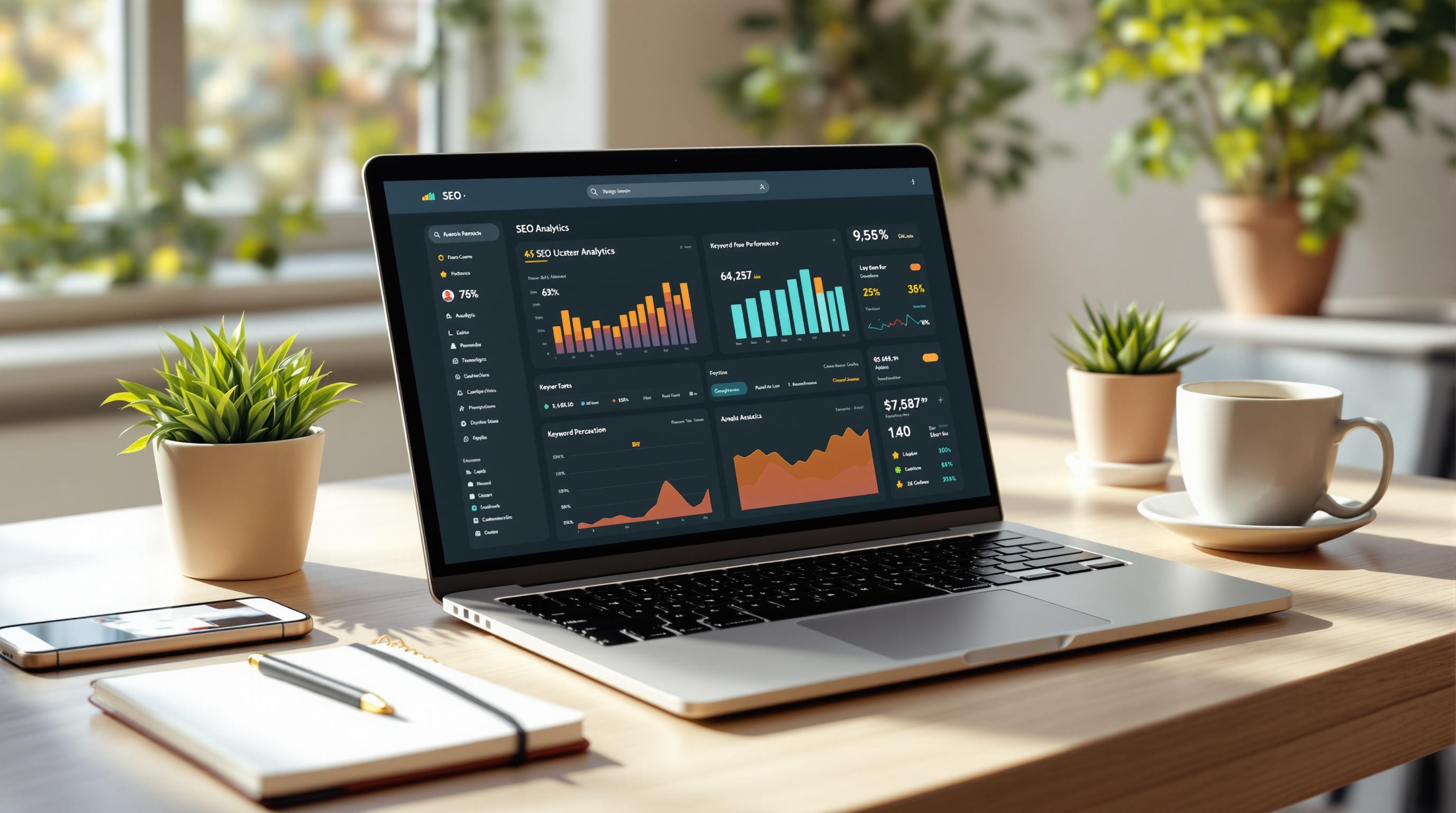SEO mistakes can quietly kill your website's traffic and rankings. Here are the 5 most common errors that hurt your site and how to fix them:
- Skipping Keyword Research: Targeting the wrong keywords wastes effort and misses ranking opportunities. Use tools like Google Keyword Planner and focus on long-tail keywords.
- Ignoring Mobile-Friendly Design: With over 55% of web traffic coming from mobile, a poor mobile experience leads to higher bounce rates and lower rankings.
- Weak Backlink Strategies: Low-quality or spammy backlinks can result in penalties. Focus on earning high-quality, relevant links.
- Duplicate Content: Confuses search engines and splits ranking signals. Use canonical tags, unique content, and regular audits to fix this.
- Neglecting Page Speed: Slow websites frustrate users and hurt rankings. Compress images, use caching, and optimize for faster load times.
Key Takeaway: Fix these mistakes to improve rankings, boost traffic, and create a better user experience. Let’s dive deeper into each issue and how to resolve it.
11 Common SEO Mistakes Beginners Make
1. Skipping Keyword Research
Good SEO starts with picking the right keywords. Without solid research, you might miss out on ranking opportunities or waste time creating content that doesn’t deliver results.
Why Poor Keyword Choices Hurt
Many mistakes in keyword selection happen when businesses assume they know how users search. Skipping research can lead to targeting terms that either no one searches for or are dominated by competitors. As WP Rocket Blog puts it:
"Choosing unsuitable key phrases is pretty much as bad as selecting none at all" [1].
| Issue | Impact on SEO and Business |
|---|---|
| Overly Broad Keywords | Tough competition, weak rankings, wasted effort |
| Irrelevant Keywords | Attracts the wrong audience, poor conversions |
| Outdated Terms | Misses current trends, reduces relevance |
How to Do Keyword Research Right
Avoid these traps by focusing on keywords that balance search volume with manageable competition [7].
Tools and Techniques to Use:
- Google Keyword Planner: Great for checking search volumes.
- Long-tail keywords: Easier to rank for and often lead to better conversions [6].
Smart Keyword Placement: Instead of going after generic terms, aim for specific phrases that align with user intent. For instance, "local SEO services" often has clearer intent and less competition compared to broader terms.
Place keywords thoughtfully in:
- Page titles and meta descriptions
- First paragraphs
- Heading tags (H1, H2, H3)
- Image ALT text
- URL structures
Make sure keywords flow naturally in your content - don’t force them in. Also, revisit your keyword strategy regularly to keep up with changing trends and user behavior [3].
While keywords are crucial, don’t forget the importance of making your site user-friendly across all devices to maintain strong rankings.
2. Ignoring Mobile-Friendly Design
If your website isn’t mobile-friendly, you’re falling behind. With Google’s shift to mobile-first indexing, how your site performs on mobile directly affects your search rankings.
Why Mobile Optimization Matters
Mobile devices now account for 55% of all web traffic, and 52% of users leave sites that don’t offer a good mobile experience [7][1]. If your site isn’t optimized for mobile, it’s not just your rankings that suffer - it’s your users, too.
Here are some common issues with mobile-unfriendly websites:
| Issue | Impact on Rankings | User Experience Impact |
|---|---|---|
| Slow Loading Speed | Lower search visibility | Higher bounce rates |
| Poor Text Readability | Reduced time on site | Frustrated users |
| Difficult Navigation | Decreased engagement | Lost conversions |
| Unoptimized Images | Slower page speed | Excessive data usage |
How to Make Your Site Mobile-Friendly
Test Your Site’s Mobile Performance
Start with Google’s Mobile-Friendly Test. It identifies specific issues and gives you a roadmap for improvements [8].
Use Responsive Design
A responsive design ensures your site adjusts automatically to different screen sizes. This makes text, buttons, images, and menus work seamlessly on every device.
Prioritize Speed
Mobile speed is a ranking factor. As seoClarity puts it:
"More than half of all searches now happen on mobile devices, making mobile optimization crucial for reaching and engaging the target audience" [2].
Key speed fixes include compressing images, minifying files, enabling caching, and removing unnecessary plugins.
Track Mobile Metrics
Use Google Analytics to monitor mobile performance. Look for areas where users drop off and make adjustments.
A Webnode client saw a 20% boost in rankings and a 15% drop in bounce rates after improving their mobile optimization [4]. This shows that mobile-friendly design doesn’t just help users - it also aligns with Google’s priorities for better rankings.
While mobile optimization enhances user experience, don’t overlook the importance of a solid backlink strategy to build your site’s authority and improve rankings further.
3. Weak Backlink Strategies
Bad backlink practices can hurt your SEO more than you might think. Quality backlinks show search engines that your site is credible, which boosts your rankings. On the other hand, poor-quality links can lead to penalties and make your site less visible in search results.
Why Bad Backlinks Are Problematic
Search engines see spammy or irrelevant links as attempts to manipulate rankings. This often results in penalties that can harm your site's performance [3].
Here are some common types of harmful backlinks:
| Backlink Type | Risk Level | Potential Impact |
|---|---|---|
| Link Farm Networks | High | Sudden ranking drops |
| Paid Low-Quality Links | High | Penalties from search engines |
| Irrelevant Site Links | Medium | Lower domain authority |
| Automated Link Schemes | High | Manual penalties by Google |
How to Build Better Backlinks
Instead of risking penalties with shady tactics, focus on earning links that genuinely boost your site's authority. Here's how to do it:
Content That Attracts Links
- Write detailed industry guides.
- Conduct and publish expert interviews.
- Share insightful case studies.
- Contribute guest posts to respected sites.
- Create content that's both unique and useful.
- Build connections with editors and publishers.
Keep Tabs on Your Backlinks
Use trusted tools to audit your backlink profile regularly. This helps you:
- Track new links to your site.
- Spot harmful or spammy links.
- Analyze link quality.
- Learn from your competitors' backlink strategies.
Network Within Your Industry
Building relationships with key players in your field can naturally lead to high-quality backlinks. Ways to connect include:
- Attending industry events or conferences.
- Engaging on social media.
- Participating in professional forums.
- Collaborating on content projects.
Make it a habit to review your backlink profile and disavow any harmful links that could hurt your site's reputation. A clean, well-maintained link profile is crucial for staying visible in search rankings.
While backlinks are essential for authority, don’t forget that the quality of your content plays a major role in maintaining strong rankings.
sbb-itb-d7fe25c
4. Dealing with Duplicate Content
Duplicate content can quietly undermine your SEO efforts. When the same or very similar content shows up on multiple URLs, it confuses search engines and weakens your site's authority, making it harder to rank for your target keywords [1].
Finding Duplicate Content
| Source | Example | Impact |
|---|---|---|
| Multiple Site Versions | www.site.com vs site.com | Splits ranking signals |
| Product Descriptions | Same text across variants | Reduces search visibility |
| URL Parameters | ?sort=price vs ?color=blue | Confuses search crawlers |
| WordPress Archives | Category/tag pages overlap | Wastes crawl budget |
To spot duplicate content issues, use tools like Google Search Console or SEMrush to audit your site. Pay close attention to product pages, category pages, international versions, and URLs with parameters.
Preventing Content Duplication
Here’s how you can tackle duplicate content effectively:
Technical Fixes
- Use canonical tags and consistent URL structures (e.g., www vs non-www, HTTPS vs HTTP) to signal the preferred version of a page to search engines [1].
- Set up 301 redirects for outdated URLs.
- Maintain uniform URL parameters to avoid unnecessary variations.
Write Unique Content
- Craft original descriptions for each product variation.
- Create distinct meta descriptions for every page.
- Develop custom content for specific locations or languages.
- Use language tags to properly handle multilingual content [1].
Schedule Regular Audits
Frequent content audits help you catch duplication issues before they become a problem. Keep an eye on:
- Repeated product descriptions
- Automatically generated content
- Syndicated material
- Redundant URL structures
Fixing duplicate content not only makes your site easier for search engines to crawl but also ensures your pages load faster - both of which are key to better rankings.
5. Neglecting Page Speed
Content and backlinks are essential for building authority, but technical elements like page speed play a crucial role in staying competitive in search rankings. Slow page speeds don’t just frustrate users - they also limit how many pages search engines can crawl, which impacts how much of your site gets indexed.
How Page Speed Impacts SEO
Research highlights the importance of fast-loading pages. For example, a one-second delay in page load time can result in a 7% drop in conversions [1]. Slow speeds increase bounce rates (especially on mobile), reduce conversion rates, and shrink crawl budgets - all of which hurt your search rankings.
"Page speed is critical - users won't wait for slow websites, and neither will search engines."
Steps to Speed Up Your Site
Here are some practical ways to improve load times:
-
Optimize Images
- Compress images without losing quality.
- Use lazy loading to delay image loading until they're visible on the screen.
- Switch to modern formats like WebP while providing fallback options.
-
Boost Performance
- Enable browser caching to store frequently used files.
- Use a Content Delivery Network (CDN) to serve content faster.
- Minify CSS, JavaScript, and HTML files to reduce file sizes.
Track Key Metrics
Keep an eye on critical performance indicators, such as:
- First Contentful Paint (FCP)
- Largest Contentful Paint (LCP)
- Cumulative Layout Shift (CLS)
Big names like Walmart and Amazon have shown that even minor improvements in load times can lead to noticeable increases in conversions and revenue. Speed matters, both for users and search engines.
Conclusion: Avoiding SEO Errors for Better Rankings
SEO is always changing, and common mistakes can drag down your rankings. Skipping keyword research or ignoring page speed can hurt both your site's performance and the experience users have on it.
For example, 53% of mobile users leave a site if it takes more than 3 seconds to load [3]. Fixing these errors is key to keeping your visitors and boosting conversions.
Here are some practical ways to improve your SEO:
- Use natural keywords to help with rankings and keep readers engaged.
- Make your site mobile-friendly to attract more organic traffic.
- Focus on creating original content to stand out in search results.
- Speed up your pages to lower bounce rates.
The best SEO strategies combine technical know-how with a great user experience. This means:
- Offering content that meets user needs.
- Ensuring your site works smoothly on all devices.
- Keeping up with technical optimization.
- Building quality backlinks from relevant websites.
As search engines grow smarter, focusing on quality and user satisfaction beats any quick fixes. Fixing these common issues builds a strong SEO foundation and sets you up for lasting success.
FAQs
Here are answers to some common questions about SEO practices you should steer clear of.
Which SEO technique should you avoid?
Certain SEO techniques can harm your website's rankings and reputation. These include:
- Keyword stuffing: Overloading content with keywords makes it look spammy and unnatural.
- Hidden or invisible text: Using text that blends into the background can lead to immediate penalties.
- Link farming: Participating in schemes to generate excessive backlinks damages your site's credibility.
- Content spinning: Producing low-quality, rewritten content offers no real value to users.
- Cloaking: Showing different content to users and search engines can result in severe penalties or even removal from search results [3].
What hurts SEO?
Several factors can negatively affect your SEO performance:
- Keyword overuse: Stuffing keywords into your content makes it feel unnatural and may lead to penalties [1][3].
- Ignoring mobile optimization: With mobile searches dominating online traffic, a site that's not mobile-friendly risks losing rankings [2][4].
- Duplicate content: Reusing existing material confuses search engines and limits ranking potential. Always aim for original, high-quality content [1][3].
- Poor user experience: Slow-loading pages, hard-to-navigate designs, and low-quality content can drive visitors away and hurt your rankings [5].
The bottom line? Focus on creating valuable, engaging content and ensuring a smooth user experience instead of relying on risky shortcuts. High-quality content is still the foundation of effective SEO.


